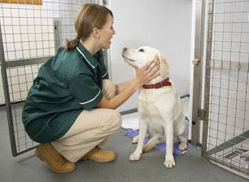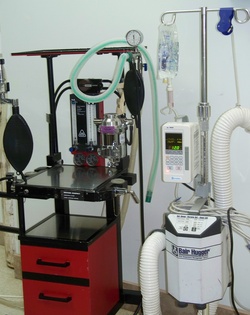A general anesthetic results in a loss of consciousness in the animal and a loss of sensation throughout the body.
We recommend a blood panel be performed prior to a general anesthetic. This is to make sure the liver and kidneys are functioning normally and that there are no underlying disease conditions present that may increase the risk of the anesthetic.
At our Clinic in most cases an animal being given a general anesthetic has a catheter inserted into a vein and is hooked onto an intravenous electrolyte drip. This helps to maintain good blood pressure throughout the procedure. It also gives the Veterinarian immediate access to a vein in an emergency situation.
Most general anesthetic procedures involve several steps beginning with the administration of a preanesthetic injectable medication. This is usually a combination of a sedative and analgesic (medication to help reduce pain).
An intravenous injection of an anesthetic renders the animal unconscious while a breathing tube is placed into the animal’s trachea. A gas anesthetic is delivered in combination with oxygen to the animal via the breathing tube to maintain the state of unconsciousness.
Although general anesthetics are very safe there is still the remote chance of an anesthetic accident.
We also use a heat pump that pumps warm air into a blanket that we cover the animals with during the procedure. This helps to maintain body temperature.
As mentioned above we reduce the risk associated with anesthesia by doing a thorough physical examination, blood work prior to anesthesia, intravenous fluids, maintaining body temperature and use proper anesthetic monitoring protocols and equipment.




